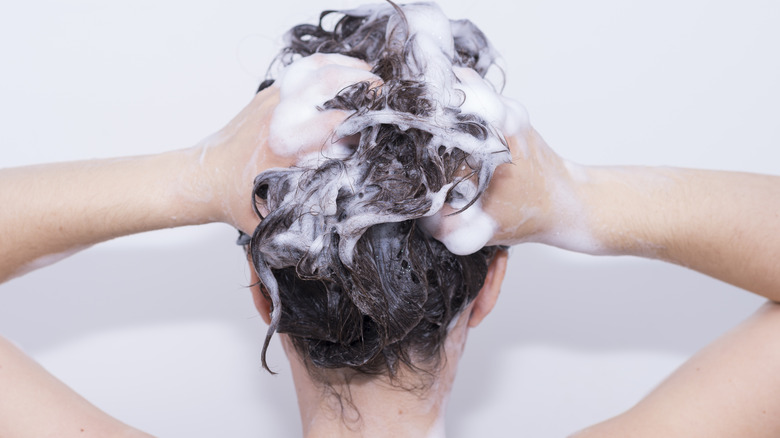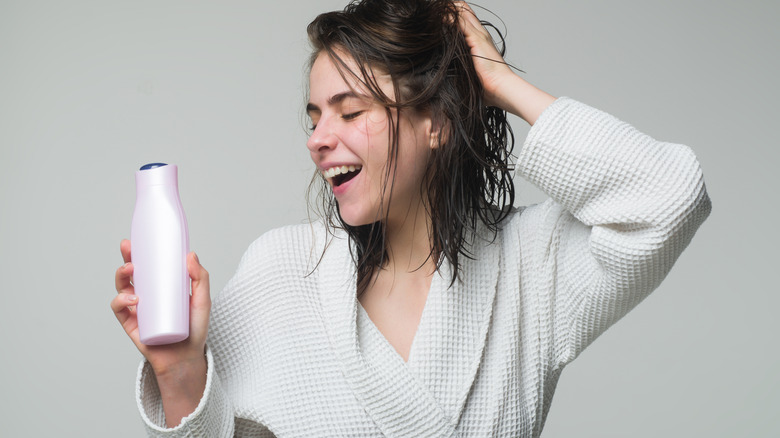How To Care For Low-Porosity Hair
If low-porosity hair was a personality, it might be a split personality. This is the type of hair that forces you to stand under the showerhead for what seems like an inordinate amount of time because it resists getting soaked. Then, once you're out of the shower, you assume your hair will dry in record time. But here's the second surprise: it can take an equally inordinate amount of time for your hair to air-dry. And if you apply mousse or another styling product? It may sit there, stubbornly refusing to be absorbed (via Healthline).
Low-porosity hair can keep you on your toes, and maybe at your wits' end. Fortunately, there are ways to gain the upper hand on low-porosity hair, or at least do an end-run in dealing with the inherent frustrations of this genetic condition. Before you do, though, it's a good idea to assess the characteristics of your hair and test its porosity. You can do this at home in a matter of minutes, and without having to purchase an expensive hair strand test. Think of it as a moment of reckoning between you and your hair so you can, as the British are fond of saying, keep your hair on.
Test your hair's porosity
Unless you've studied strands of your hair under a microscope, you may not know that hair consists of three layers: the cuticle, or the outermost layer; the cortex, or the middle layer where most of the heft and pigment lies; and the medulla, or the central layer (via Medical News Today). Porosity turns on the cuticles. When they're packed so close together that they overlap, hair is of low porosity. This is why it repels moisture, takes a long time to dry, and clings to hair products. Low-porosity hair also tends to be difficult to style, and it can be dry at its ends (via Mielle).
Although these distinctive qualities point to low-porosity hair, conduct a "float test" to be certain. First, make sure that your hair is clean and free of product. Cut an inconspicuous strand of your hair and drop it in a glass of tepid water. If the strand floats, it's probably of low porosity. But if it sinks, it's likely highly porous. An alternative porosity test works best with a trusted partner who can give you a hand. Since you know that low-porosity hair resists water, you can rightly assume that this resistance is often visible to the eye. So, have your partner spray some water on one area of your hair. Low-porosity hair often turns water into tiny beads. This transformation may occur gradually or immediately. In this case, your observant partner can tell you for sure.
Exert a light touch
Given what you know about low-porosity hair, common sense dictates that you want to lighten the load on your hair as much as possible. Since all shampoos and conditioners are not made equally, choose those that do not leave undue residue on your hair, though you'll have to try some first to expose which ones they are. Water-based products are often best because they should be naturally lightweight. Read the ingredient label for direction. This is because water should be one of the first ingredients listed (via Mielle). If it's not, or you're unhappy with the amount of residue, dilute the shampoo or conditioner with a little water before applying it to your hair.
Since low-porosity hair naturally resists moisture and oil, you may have to take an extra step to outfox it by applying a deep conditioner once a week, especially if your ends are dry. An effective way to do this is to apply the deep conditioner to your hair and then cover your head with a thin shower cap. As the conditioner goes to work on your hair, run warm air from a blow dryer over your head for a few minutes to open the cuticles (via Healthline). As long as you're inspecting labels, look for protein-free hair products and ones that contain natural ingredients, including citrus extract. Protein can cause low-porosity hair to become stiff and more fragile. And this is bad news for hair that already has one too many personalities as it is.


